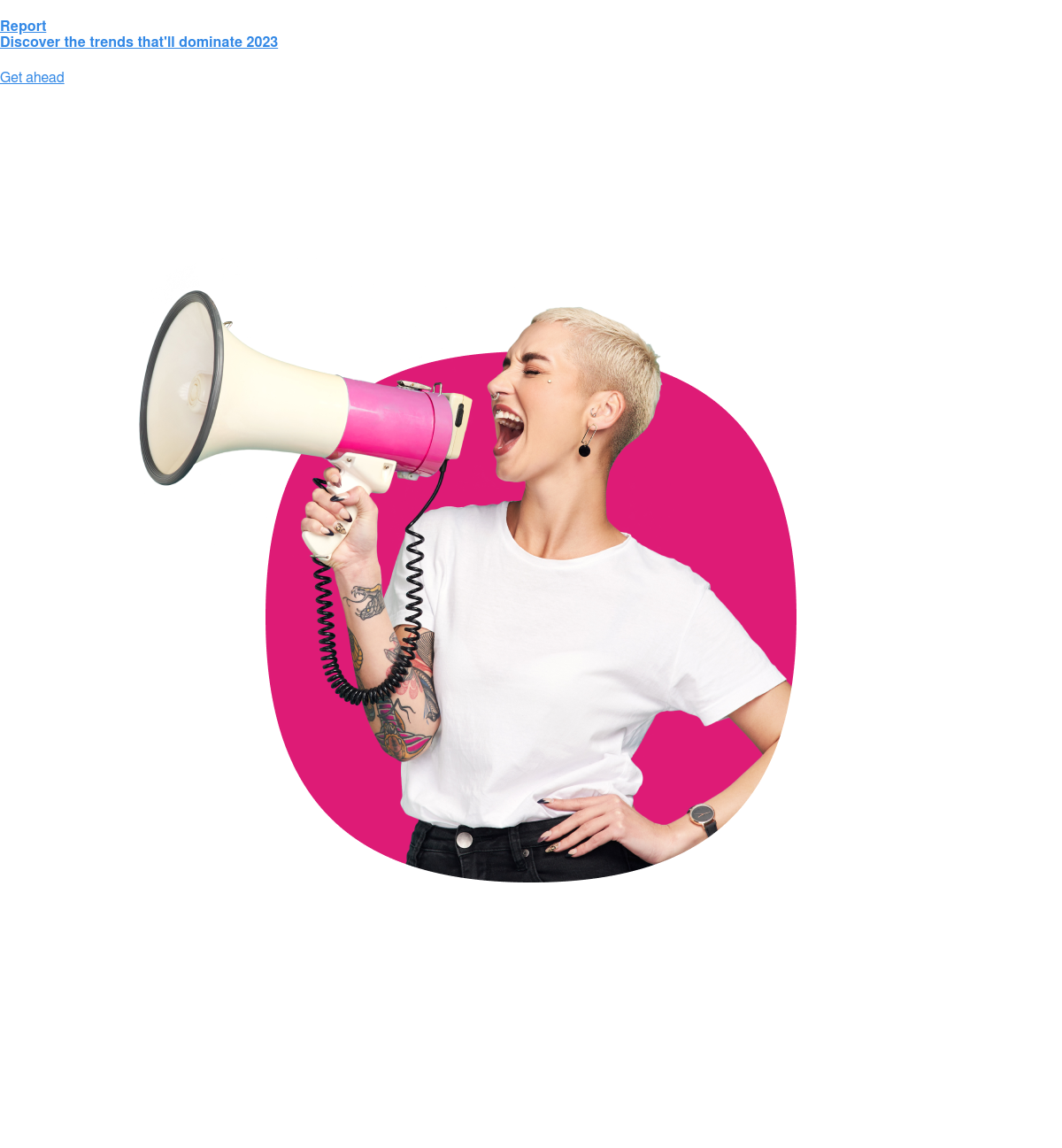Looking to dip your toe into TikTok? Wondering if Reels are reely the only way to spike your engagement on Instagram? Or maybe you’re wondering whether Twitter is still the right platform for your business? Social media marketing can feel like a minefield, but have no fear, we’re here to help.
We’ve got the lowdown on what content works best on TikTok, Instagram, and Twitter in 2023, and what consumers want when it comes to entertainment and shopping on social.
- What content works best on TikTok?
- What content works best on Twitter?
- What content works best on Instagram?
- What content works best for social commerce?
Deciding which content is right for each platform
The social media space is always changing, and some people feel that the leading giants are all starting to look the same.
It’s true there’s a lot of crossover between audiences, and many platforms have similar features, but people still open each app with a specific experience in mind. And, let’s not forget, most consumers have more than one social app that they use on a regular basis.
On average, Gen Z and millennials have over 6 social media accounts, while baby boomers have over 4
So, it’s not just small differences in formats or character limits that marketers need to bear in mind, it’s also the vibe. Each app offers users something different, which is why social media marketing should never be a copy-paste job, and why up-to-date data is invaluable.
Let’s take a deep dive into what you need to know about some of today’s most talked-about audiences to help you tailor your content more effectively.
How to win on TikTok
Before we get into it, it’s worth noting that TikTok is slightly different to other platforms in that they don’t see themselves as a social media app; president of global business solutions Blake Chandlee says TikTok’s an entertainment platform. So while there may be some notable similarities, it’s best to approach TikTok marketing with completely fresh eyes.
So, what do users want from TikTok?
Most TikTok users are on the same page: 60% say they want funny content. Marketers hoping to resonate with as many users as possible will increase their chances by prioritizing humor.

Not only do TikTok users want to see funny content, but creative and relaxing content ranks highly too. Users are using TikTok as a way to be inspired, but also as a way to relax. Cooking, pottery, makeup tutorials, and DIY videos are just a handful of examples of creative content that can be found on the platform.
That’s not to say brands have to choose one or the other. Businesses can tick both boxes by being bold and surprising, and at the same time silly and unpolished – as users clearly see the TikTok as a safe space to be goofy and impulsive.
The brand Cult Beauty does this well, putting out funny and relatable TikTok videos on everything from skincare and viral makeup trends, to work-related memes.
British retailer M&S is another example of a brand who on the face of it may not be particularly fun or trendy, but have been able to create a playful alter-ego on TikTok with their video content, appealing to the younger generations.
How to win on Twitter
Despite Twitter having a long-standing association with humor (who remembers this gem from Sean Paul back in 2021?) platform users are less bothered about funny content compared to other platforms.
Towards the end of 2022, Elon Musk declared “Comedy is now legal on Twitter”, but it still remains to be seen if the platform will get back to the Comedy Twitter glory days of the early 2010s.
Twitter users rank funny content third behind informative and relevant content, so if your brand has something more serious to say or news to share, Twitter might be the best place for it.
53% of weekly Twitter users say they want content on Twitter to be informative, which may not be surprising considering Twitter is the platform many flock to for political debates and news updates, especially breaking news and fast-moving stories.

However, something that may pique your interest is the subtle shift we’ve seen in the types of content Twitter users want to see since February 2022. While the top content ‘vibes’ remain relatively unchanged, inspirational content fell down the ranks, while community-driven content grew in favor.

Content that’s relaxing also dipped in popularity, suggesting users may be getting their chill fix from other apps. ASMR on TikTok, we’re looking at you…
Giving consumers what they want on Twitter
Companies need to stay on top of what’s being talked about online, and adding their own perspective to a retweet is an easy way to contribute to a topic that users have already made clear is relevant.
But as ever, it’s important brands are authentic in their approach, and are mindful of what they engage with and how. Take time to understand your audience and the issues that matter to them before deciding whether it’s appropriate and authentic to contribute to the conversation.
In line with consumer expectations, Twitter is a great place to share blogs offering advice, engage to customer queries, and post longer content in the form of Twitter threads to spark new conversations.
How to win on Instagram
Despite fierce competition from other platforms, Instagram is among the top two platforms for Gen Alpha and Gen Z. In fact, it’s Gen Z’s favorite overall, with 29% saying it’s their go-to platform.
Instagram’s vibe has changed over time. When it first appeared on the scene, Instagram was all about aspirational content. Today, according to its CEO, it’s no longer a photo-sharing app and instead is leaning much more on entertainment (like TikTok in fact).
That’s put Reels in the spotlight. Since 2020, there’s been a nearly 40% increase in the number watching/uploading Reels – while the number creating Stories hasn’t budged.
Gen Z are 43% more likely than millennials to say Instagram is their favorite social media platform

The move away from images to video has surely influenced user preferences, with ‘funny’ currently the most in-demand vibe among Instagrammers. We’ve seen an explosion of memes, Instagram Reels, and funny videos, some a result of cross-pollination from TikTok.
Authentic, personable content is a trend in itself, with Instagrammers caring more about whether content is trendy than whether it’s relevant, and it’s easy to understand why.
Instagram users are much more likely to follow meme accounts, watch streaming services daily, and be interested in celebrity news. Users are on top of popular culture, and as a result, they’re 22% more likely to want brands to be trendy or cool.
Dunkin Donuts was one of many brands to take part in Dolly Parton’s challenge back in 2020, and more recently ASOS created ‘Barbiecore’ looks on Instagram, inspired by the new Barbie movie. On the aesthetic side of things, unedited photo dumps, in-app fonts, and blurred shots are all in style right now. Brands hoping to strike a chord and drive engagement with these trend-followers should sprinkle this kind of content throughout their profile.
Turning scrollers into shoppers
A major trend we explored in our most recent Connecting the dots report is social commerce. There’s a new generation of social shoppers emerging that brands need to stay close to.
The number of consumers doing their shopping-related research on social networks has shot up since 2015, and these platforms have even surpassed search engines among Gen Z; 50% head to social media for product research, compared to 45% for search.
Gen Z is also the audience most likely to find new products via social ads, so if they’re a core audience for you, it could pay to invest in ads. The key to hitting the mark is understanding where your target audience are, and the type of content they want to see first, before you worry about a platform or format.
Another key change to take note of is shifting attitudes towards reviews as shoppers get more savvy. Since Q1 2021, there’s been a 7% drop in the number of Gen Z who say they trust what online reviews say about products and services.
With the rise of fake news and de-influencing, we’re generally seeing consumers adopt a more skeptical attitude to product reviews, sponsored posts by content creators, and celebrity endorsements. One solution is user-generated content which can really help to inject authenticity and pave the path to purchase.
Telling the same story differently
Today, brands need to be able to tell their story in multiple ways, something they can only do after they’ve learnt what works and where.
There are quite a few natural overlaps between platforms. For example, funny and creative content are hallmarks of TikTok and Instagram’s audiences, which makes both apps good candidates for cross-posting.
There’s really no need to reinvent the wheel with all this; repurposing material can be a major time-saver and help smaller businesses gain brand visibility more quickly.
Our research is just a friendly reminder to make those all-important tweaks, as sometimes it’s less about what you’ve got, and more about how you post it.









